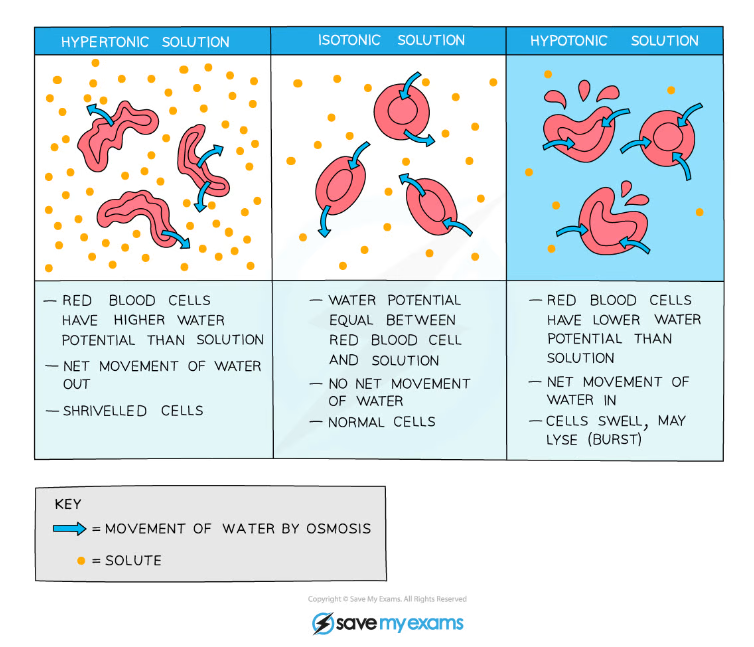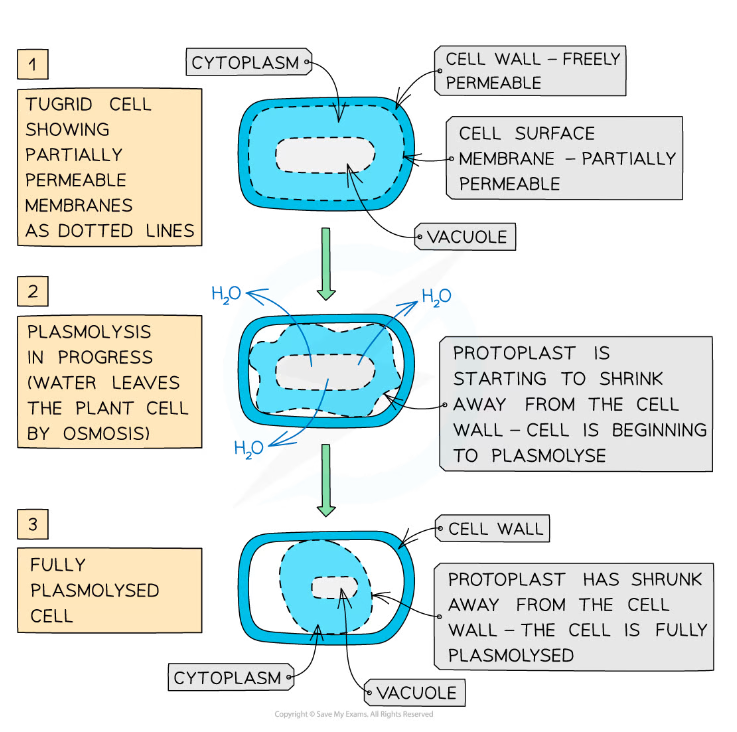- 翰林提供学术活动、国际课程、科研项目一站式留学背景提升服务!
- 400 888 0080
OCR A Level Biology:复习笔记2.5.8 Osmosis in Animal & Plant Cells
Osmosis in Animal & Plant Cells
Osmosis in animal cells
- Animal cells can lose and gain water as a result of osmosis
- As animal cells do not have a supporting cell wall (unlike plant cells), the results of this loss or gain of water on the cell are severe
Animal cells losing water
- If an animal cell is placed in a solution with a lower water potential than the cell (such as a concentrated sucrose solution)
- Water will leave the cell through its partially permeable cell surface membrane by osmosis and the cell will shrink and shrivel up
- This is crenation (the cell has become crenated), which is usually fatal for the cell
- Crenation occurs when the cell is in a hypertonic environment (the solution outside of the cell has a higher solute concentration than the inside of the cell)
Animal cells gaining water
- If an animal cell is placed in pure water or a dilute solution, water will enter the cell through its partially permeable cell surface membrane by osmosis, as the pure water or dilute solution has a higher water potential
- The cell will continue to gain water by osmosis until the cell membrane is stretched too far and the cell bursts (cytolysis), as it has no cell wall to withstand the increased pressure created
- This is fatal for the cell
- Lysis occurs when the cell is in a hypotonic environment (the solution outside of the cell has a lower solute concentration than the inside of the cell)
- This is why a constant water potential must be maintained inside the bodies of animals
Animal cells in isotonic environments
- If an animal cell is in an isotonic environment (the solution outside of the cell has the same solute concentration as the inside of the cell)
- The movement of water molecules into and out of the cell occurs at the same rate (no net movement of water) and there is no change to the cells

Effect of osmosis on animal cells
Osmosis in plant cells
- Like animal cells, plants cells can also lose and gain water as a result of osmosis
- As plant cells have a supporting cell wall, the results of this loss or gain of water on the cell are less severe than in animal cells
Plant cells losing water
- If a plant cell is placed in a solution with a lower water potential than the plant cell (such as a concentrated sucrose solution), water will leave the plant cell through its partially permeable cell surface membrane by osmosis
- As water leaves the vacuole of the plant cell, the volume of the plant cell decreases
- The protoplast gradually shrinks and no longer exerts pressure on the cell wall
- As the protoplast continues to shrink, it begins to pull away from the cell wall
- This process is known as plasmolysis – the plant cell is plasmolysed

Plasmolysis of a plant cell that has been placed in a solution with a lower water potential than the cell itself
Plant cells gaining water
- If a plant cell is placed in pure water or a dilute solution, water will enter the plant cell through its partially permeable cell surface membrane by osmosis, as the pure water or dilute solution has a higher water potential than the plant cell
- As water enters the vacuole of the plant cell, the volume of the plant cell increases
- The expanding protoplast (living part of the cell inside the cell wall) pushes against the cell wall and pressure builds up inside the cell – the inelastic cell wall prevents the cell from bursting
- The pressure created by the cell wall also stops too much water from entering and this also helps to prevent the cell from bursting
- When a plant cell is fully inflated with water and has become rigid and firm, it is described as fully turgid
- This turgidity is important for plants as the effect of all the cells in a plant being firm is to provide support and strength for the plant – making the plant stand upright with its leaves held out to catch sunlight
- If plants do not receive enough water the cells cannot remain rigid and firm (turgid) and the plant wilts

Osmosis of water into a plant cell
Comparing & Contrasting the Movement of Water by Osmosis in Plant & Animal Cells Table

Exam Tip
Be careful with your scientific terminology – animal cells do not plasmolyse because they do not have a cell wall. In a solution with a lower water potential than the cell itself, animal cells will shrink. Plasmolysis only occurs in plant cells.Remember – plant cell membranes are composed of a phospholipid bilayer and are partially permeable (only certain molecules can cross), whereas plant cell walls are made of cellulose and are freely (fully) permeable. Thus, in a plasmolysed cell, the external solution will be exerting pressure on the protoplast (there is not an empty space between the cell wall and protoplast).
转载自savemyexams

早鸟钜惠!翰林2025暑期班课上线

最新发布
© 2025. All Rights Reserved. 沪ICP备2023009024号-1








